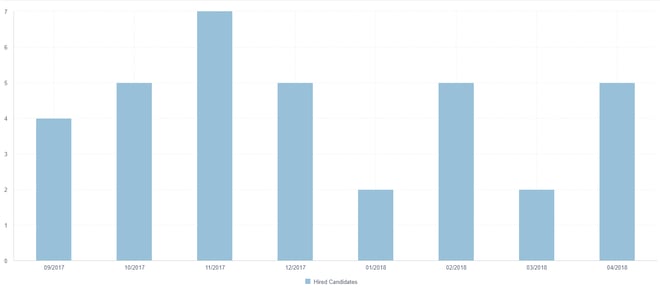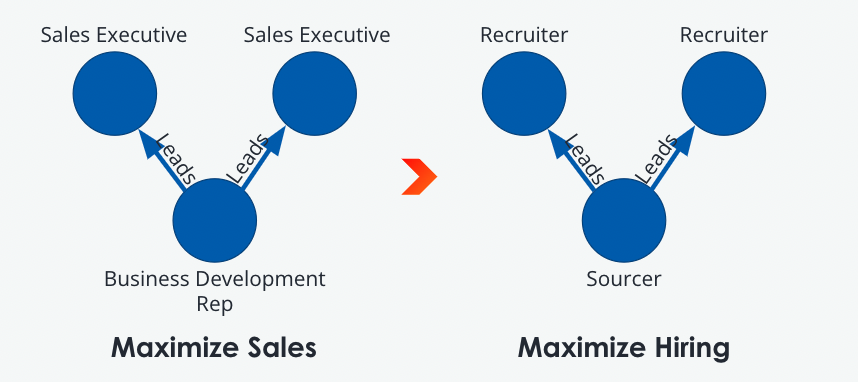 In today’s post, we interviewed ClearCompany’s Director of Talent Acquisition, Brian Abraham. With 20 years of experience recruiting for high-growth technology companies spanning corporate, agency, and services consulting, Abraham is passionate about connecting A-level talent with pivotal and engaging career opportunities. Within his previous roles before joining ClearCompany, Brian was tasked with developing and executing transformative talent growth strategies in the nation’s top tech hubs and creating programs for veteran and diversity hiring, employment branding, and campus recruiting.
In today’s post, we interviewed ClearCompany’s Director of Talent Acquisition, Brian Abraham. With 20 years of experience recruiting for high-growth technology companies spanning corporate, agency, and services consulting, Abraham is passionate about connecting A-level talent with pivotal and engaging career opportunities. Within his previous roles before joining ClearCompany, Brian was tasked with developing and executing transformative talent growth strategies in the nation’s top tech hubs and creating programs for veteran and diversity hiring, employment branding, and campus recruiting.
At ClearCompany, our mission is to help our clients achieve their missions by hiring, engaging, and retaining A Players. But we can’t do that without hiring our own team of A Players — and we've done just that, growing by more than 60% since 2018 thanks to our outstanding recruiting team and their fresh approach to recruiting, sourcing, and staffing their own team.
Today, we’re talking to ClearCompany’s Director of Talent Acquisition, Brian Abraham, to dig into what’s driving our recruiting success. Brian started at ClearCompany in 2017, and since then, he’s built a solid recruiting team structure that has helped ClearCompany grow to 242 employees today.
Find out how Brian saw the opportunity to add a valuable role to the talent acquisition team and how ClearCompany’s recruiting team is structured for maximum hiring success.
@ClearCompany’s Talent Acquisition team includes a less common role that enables consistent, quality hiring — find out what it is and learn how to structure your #recruiting team for hiring success:Q: How does a typical recruiting team operate?
Brian A: Most recruiting teams are staffed with recruiters managing the full talent lifecycle, and that’s how ClearCompany began, too. That means you have a recruiter that does everything. They source; they screen; they schedule interviews with the hiring team; they negotiate; they make offers — everything. This graph from my early days at ClearCompany shows the results of a team executing full lifecycle recruiting. As recruiters’ hiring activity grows — as they screen, schedule, interview, and make offers to candidates — there is an inverse relationship with sourcing. Because of the increased time spent on these other critical tasks, candidate sourcing drops to zero.
ClearCompany Hiring Activity

As an individual recruiter, I can't get all these candidates to the point of an offer and still source people. So when I turn around and start recruiting again, I have to start from scratch, and then the cycle just replays.
That's essentially what we used to do. That's what most companies do — they bring recruiters on, oftentimes when lack of hiring has reached a crisis point, and they say, "Just get it done!" And so you have the cycle of heavy sourcing, then you start scheduling multiple rounds of interviews and working those candidates through to an offer acceptance, and then sourcing dives again. If you find you're still not keeping up with demand, you hire more recruiters.
"We have made major strides toward increasing diversity at ClearCompany, and it’s come naturally with the addition of the candidate sourcer role."
- Brian Abraham, Director of Talent Acquisition at ClearCompany
Q: Describe the structure of ClearCompany’s recruiting team and how it’s different from a typical recruiting team.
Brian A: My first year at ClearCompany, during which time I was the lone recruiter, the company celebrated big wins with small teams — we were fighting outside our weight class, so to speak. We established our partnership with ADP and secured funding from Primus Capital.
That was a turning point for ClearCompany and for me: I realized that I had the same chance with recruiting. Would I be able to utilize the ClearCompany platform and methodologies to fight outside of my weight class in talent acquisition and achieve results we had not yet seen? We needed to refine our processes to optimize our performance and transport the maximum number of A Players through our process.
Find out how @ClearCompany’s Director of Talent Acquisition structured the #recruiting team for hiring success in this Q&A (hint: #CandidateSourcers):My solution to even out the ups and downs of full talent lifecycle recruiting was to hire dedicated sourcers for the recruiting team. I saw Google doing it — hiring senior-level recruiters just to source candidates — and I had never worked in an environment where that was done. Every other company I'd worked for previously would hire for a recruiting specialty like sales or technology, assign you to work with those managers, and then set you loose to manage every detail of a highly demanding requisition load.
At one company I was assigned 80 requisitions. So, it's high volume, high pressure, and you're working through these up-and-down cycles to hit an often unattainable target.
Candidate sourcers have just one job, to find qualified candidates and send them through to recruiters. It’s like a business development representative on a sales team. Their whole role is to generate leads and send them to the sales reps, who can then reach out. It’s the same with candidate sourcing, and under this model, sourcing remains constant while recruiters are enabled to focus on late-stage activities and build strategic partnerships with their hiring teams.

So in late 2018, we hired a dedicated candidate sourcer and then had three record hiring months— even in a month like December, where you typically see less hiring. We hired 34 people that quarter, growing 30% in just 90 days. At that time, we did the same volume of hiring for niche Software as a Service (SaaS) roles with a team of two — one sourcer and one recruiter — that other companies were doing with teams three or four times that size.
“We hired 34 people [in Q4 2018], growing 30% in just 90 days. At that time, we did the same volume of hiring for niche Software as a Service (SaaS) roles with a team of two — one sourcer and one recruiter — that other companies were doing with teams three or four times that size.”
- Brian Abraham, Director of Talent Acquisition at ClearCompany
Today, ClearCompany’s recruiting team is lean for the amount of hiring we do, with only five members. We have three recruiters and two candidate sourcers, one of which splits sourcing and scheduling duties. She'll eventually move into a full sourcing role and we will split scheduling responsibilities evenly across our sourcers. We want to keep the scheduling piece off of the recruiters’ plates so they can focus on later-stage recruiting activities and have that assistance to move candidates through the interviewing process.
Q: What’s the most important takeaway about team structure for other recruiting teams?
Brian A: I think the most important takeaway from a high level is that you have to develop a culture of curiosity about every part of your existing process, a willingness to dissect its parts, then adapt quickly to your findings — especially within a volatile market. In this case, we looked at our data to identify major deficits and inefficiencies within a very common recruiting structure that our current process was creating. We changed it.
“The most important takeaway from a high level is that you have to develop a culture of curiosity about every part of your existing process, a willingness to dissect its parts, then adapt quickly to your findings — especially within a volatile market.”
- Brian Abraham, Director of Talent Acquisition at ClearCompany
We also acknowledge that sourcing is not a part of the process you take lightly. It is where the battle for talent begins and is won, where accuracy determines your hiring efficiency, and where you develop a diverse talent community. If you're not winning at the top of the funnel, you're not going to win at the hiring stage, and your business will probably look very different from its original vision and mission.
Investing in dedicated sourcers has benefited so many aspects of our talent acquisition program, and has allowed us to continue to fight outside of our weight class.
Stay tuned for Part 2 of our interview, where Abraham gets specific about the new, more efficient recruiting strategies he introduced that the team still uses today.
In the meantime, find out more about how you can create an efficient hiring process — download our Guide to Placing Your Candidate Experience Front and Center.


